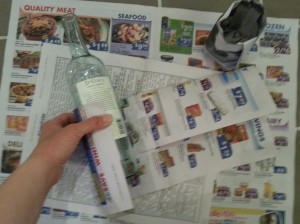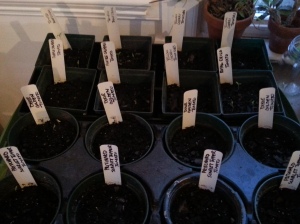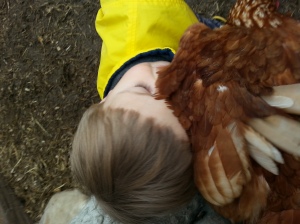Seed starting time!
W and I have been determined to do things slightly less chaotically this spring than usual. Every spring, suddenly we’re behind, it’s super warm, and we’re a hot mess of “when are we going to find time to start seedlings” and dirt on the kitchen floor. But, for the first time in my 9+ years of having a full garden, I believe I ordered my seeds BEFORE they were supposed to be planted! Also, we started a garden journal where we can keep track of our planting schedule, garden plots and other garden tidbits each year. It has helped to make room in advance on our calendar – after all, this is a priority!
 This year, we’ll start out with 4 garden beds, hoping to add more. They are pseudo-raised beds, made from salvaged timbers we found strewn around and under the barn when we moved. We’ve filled them with grass clippings and leaves in the fall and sprinkled in chicken manure over the winter to kill the underlying grass and enrich the soil. A month before we plant – so, soon – we’ll rent a tiller and till in the compost to prep for planting. Then we don’t plant to re-till, but instead find some sort of balance between a raised bed and a no-till bed. We’ll let you know how this all works out, of course!
This year, we’ll start out with 4 garden beds, hoping to add more. They are pseudo-raised beds, made from salvaged timbers we found strewn around and under the barn when we moved. We’ve filled them with grass clippings and leaves in the fall and sprinkled in chicken manure over the winter to kill the underlying grass and enrich the soil. A month before we plant – so, soon – we’ll rent a tiller and till in the compost to prep for planting. Then we don’t plant to re-till, but instead find some sort of balance between a raised bed and a no-till bed. We’ll let you know how this all works out, of course!
 Our go-to potting system in the past has been to create small, compostable newspaper planters, filled with organic potting soil to start our seeds. It’s easy to do, albeit a little messy. Roll a folded piece of newsprint around a wine bottle (about half-way up), tuck the ends into the divot in the bottom of the bottle, slide it off and then fold down the cup’s edges to make it more secure. Adding dirt holds the cup in place. Plant, whole, or slightly broken up, when the time comes. However, my mom gave us dozens of small seed-starting pots that she had been collecting, so we’re nixing the above method for something a little less
Our go-to potting system in the past has been to create small, compostable newspaper planters, filled with organic potting soil to start our seeds. It’s easy to do, albeit a little messy. Roll a folded piece of newsprint around a wine bottle (about half-way up), tuck the ends into the divot in the bottom of the bottle, slide it off and then fold down the cup’s edges to make it more secure. Adding dirt holds the cup in place. Plant, whole, or slightly broken up, when the time comes. However, my mom gave us dozens of small seed-starting pots that she had been collecting, so we’re nixing the above method for something a little less  DIY and a little more time saving. Another aspect of seed starting that has been a struggle in the past is seed markers. I’ve used color systems, charts, popsicle sticks, and markers of all shapes and sizes…to mediocre luck at knowing what I’m planting come transfer time. This year I found an ingenious solution that I think will weather the 8 weeks and beyond – lengths of Venetian blind slats (I want to get rid of all the old blinds in this house, anyway; cutting one up was very satisfying) with permanent marker notations. Not only are they sturdy, but they look rather professional, if I do say so myself!
DIY and a little more time saving. Another aspect of seed starting that has been a struggle in the past is seed markers. I’ve used color systems, charts, popsicle sticks, and markers of all shapes and sizes…to mediocre luck at knowing what I’m planting come transfer time. This year I found an ingenious solution that I think will weather the 8 weeks and beyond – lengths of Venetian blind slats (I want to get rid of all the old blinds in this house, anyway; cutting one up was very satisfying) with permanent marker notations. Not only are they sturdy, but they look rather professional, if I do say so myself!
Two weekends ago we started our earliest seeds – tomatoes (8 varieties, half pastes), radishes (2 varieties), arugula, bell peppers, Serrano peppers, onions, cabbages, and eggplant. We also started about 50 asparagus seeds, which is going to be interesting – we’d like a permanent asparagus bed, but know it takes time. Everything we’re planting is either heirloom or organic (or both). Most of what we’re planting is from seeds we’ve kept from previous years. WV and I use a turkey baster to gently water them every other day. The radishes and arugula popped up within a few days (!) but the tomatoes were worrying me…on the 7th day I looked up some info and found that covering them with plastic to trap moisture would help them. I also turned on a space heater nearby to warm things up. Two days later, and we had baby tomatoes!!!


This weekend we’ll plant beans, Brussel sprouts, collards, kale, and swiss chard. In mid-March we’ll plant cucumbers, pumpkins, summer squash, watermelon and other melons. We’ll direct sow carrots, corn, soy, hops, spinach and lettuce. We’d like to build some frames for training cukes, beans and hops up. And the flowers, oh the flowers. We’re going to till up a strip of space between the house and garden beds for some serious fleurs. Sunflowers, coxcombs, Yorktown onions, zinnias, lupine, and a variety of wild flower mixes. Also, there’s a little secret garden tucked away in the corner of the house (have already planted a fig tree, a honeysuckle vine, and a rose bush there) where some more flowers can go.
We have spring fever, clearly! Do you? Have you started your garden planning/planting yet? What are you doing differently this year?
This post is shared with Crafty Garden Mama’s Tuesday Greens, the Backyard Farming Connection’s Hop, Back to the Basics Tuesday’s With a Twist Hop, Maple Hill 101’s Hop, Tilly’s Nest Down Home Hop, Montana Homesteader’s Green Thumb Thursday, Oak Hill Homestead’s HomeAcre Hop, and Grassfed Mama’s Simple Saturday Hop.



















